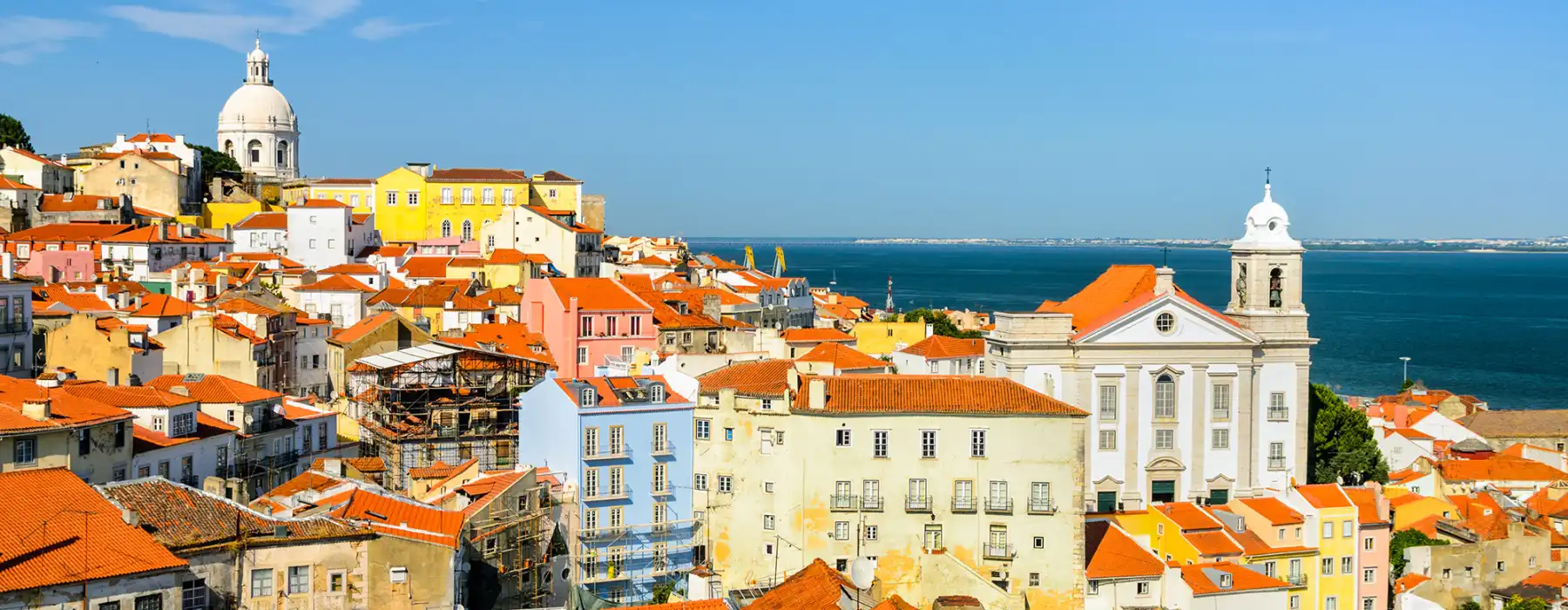- Online car rental since 2005

Car Rental Lisbon
Save time and money. We compare the offers of car rental companies in Lisbon on your behalf.
- Free cancellation Up to 48 hours prior to the scheduled pick-up time
- Best price guarantee Have you found a better price? Let us know and we will make you a better offer.
- 24000+ pick-up locations Locations around the world

Car Rental Lisbon
EasyTerra Car Rental Lisbon is an independent car rental comparison site. Our site compares prices from well-known car rental companies so that, as a customer, you can always reserve your car with us at a competitive rate.
Car rental offers in Lisbon
Whether you're looking for a small rental car or a station wagon for the entire family, we will always have a suitable vehicle at the lowest price. Below are some examples from our selection in Lisbon.

-
BeRent From€ 2 /day -
Green Motion From€ 2 /day -
wheego From€ 3 /day

-
Klass Wagen From€ 3 /day -
Europcar From€ 24 /day

-
Tangerine From€ 5 /day -
Sicily by Car From€ 6 /day -
Drive On Holidays From€ 7 /day

-
Klass Wagen From€ 3 /day -
SurPrice car rentals From€ 3 /day -
Turisprime From€ 12 /day

-
Klass Wagen From€ 3 /day -
Turisprime From€ 12 /day -
SurPrice car rentals From€ 20 /day

-
Sicily by Car From€ 6 /day -
Drive On Holidays From€ 7 /day -
Goldcar From€ 13 /day

-
SurPrice car rentals From€ 3 /day -
OK Mobility From€ 4 /day

-
SurPrice car rentals From€ 3 /day -
Goldcar From€ 4 /day -
Drive On Holidays From€ 4 /day

-
Drive On Holidays From€ 9 /day

-
Klass Wagen From€ 2 /day -
OK Mobility From€ 5 /day -
FireFly Car Rental From€ 8 /day

-
Klass Wagen From€ 3 /day -
Record Go From€ 4 /day -
wheego From€ 4 /day

-
BeRent From€ 5 /day -
Turisprime From€ 14 /day -
Drivalia From€ 32 /day

-
wheego From€ 3 /day -
Green Motion From€ 3 /day -
SurPrice car rentals From€ 3 /day

-
Klass Wagen From€ 3 /day

-
Sicily by Car From€ 7 /day -
Record Go From€ 10 /day -
Thrifty From€ 11 /day

-
Green Motion From€ 3 /day -
SurPrice car rentals From€ 3 /day -
BeRent From€ 6 /day

-
Green Motion From€ 3 /day -
OK Mobility From€ 5 /day

-
BeRent From€ 8 /day -
Budget From€ 14 /day -
Green Motion From€ 36 /day

-
Klass Wagen From€ 2 /day -
OK Mobility From€ 7 /day -
FireFly Car Rental From€ 15 /day

-
Klass Wagen From€ 3 /day -
wheego From€ 6 /day -
Record Go From€ 6 /day

-
Sicily by Car From€ 8 /day -
Green Motion From€ 11 /day -
Dollar Rent a Car From€ 13 /day

-
Klass Wagen From€ 3 /day

-
Klass Wagen From€ 3 /day -
OK Mobility From€ 7 /day -
FireFly Car Rental From€ 9 /day

-
Sicily by Car From€ 9 /day -
Green Motion From€ 11 /day -
Thrifty From€ 17 /day

-
Green Motion From€ 4 /day -
Sixt From€ 15 /day

-
Green Motion From€ 4 /day -
Drive On Holidays From€ 6 /day

-
Klass Wagen From€ 10 /day

-
wheego From€ 5 /day

-
Record Go From€ 5 /day -
BeRent From€ 43 /day -
Sixt From€ 49 /day

-
Record Go From€ 11 /day -
Sixt From€ 55 /day

-
Klass Wagen From€ 5 /day -
Tangerine From€ 7 /day -
Goldcar From€ 8 /day

-
Record Go From€ 6 /day

-
Record Go From€ 12 /day -
Guerin From€ 16 /day -
Enterprise From€ 19 /day

-
Record Go From€ 6 /day

-
Record Go From€ 6 /day

-
Record Go From€ 13 /day

-
Klass Wagen From€ 4 /day

-
Klass Wagen From€ 9 /day -
Sixt From€ 26 /day

-
Guerin From€ 18 /day

-
OK Mobility From€ 11 /day -
Dollar Rent a Car From€ 50 /day -
Thrifty From€ 54 /day

-
Tangerine From€ 11 /day -
Green Motion From€ 12 /day -
Europcar From€ 25 /day

-
CRC car rental company From€ 22 /day

-
Green Motion From€ 12 /day

-
Green Motion From€ 12 /day

-
Goldcar Key'n Go From€ 23 /day -
Keddy By Europcar From€ 32 /day -
Goldcar From€ 41 /day

-
Klass Wagen From€ 7 /day

-
Klass Wagen From€ 7 /day

-
Klass Wagen From€ 13 /day

-
Klass Wagen From€ 9 /day -
Record Go From€ 22 /day -
Europcar From€ 82 /day

-
Guerin From€ 25 /day

-
Tangerine From€ 16 /day -
Europcar From€ 64 /day -
Budget From€ 65 /day

-
Guerin From€ 21 /day -
Drive On Holidays From€ 31 /day

-
Record Go From€ 27 /day -
Europcar From€ 82 /day

-
Guerin From€ 22 /day

-
OK Mobility From€ 11 /day

-
Record Go From€ 13 /day

-
Record Go From€ 15 /day

-
Drive On Holidays From€ 15 /day

-
Guerin From€ 19 /day

-
Guerin From€ 19 /day

-
Guerin From€ 19 /day

-
Guerin From€ 19 /day

-
Guerin From€ 19 /day -
Drive On Holidays From€ 32 /day -
Alamo From€ 34 /day

-
Green Motion From€ 4 /day -
OK Mobility From€ 7 /day -
wheego From€ 7 /day

-
Green Motion From€ 4 /day -
Drive On Holidays From€ 9 /day

-
Sicily by Car From€ 13 /day -
Green Motion From€ 17 /day -
Turisprime From€ 20 /day

-
Klass Wagen From€ 5 /day -
FireFly Car Rental From€ 14 /day

-
Klass Wagen From€ 6 /day -
Guerin From€ 12 /day -
Thrifty From€ 13 /day

-
Record Go From€ 14 /day

-
Record Go From€ 6 /day -
Drive On Holidays From€ 12 /day -
Budget From€ 16 /day

-
Record Go From€ 6 /day -
Drive On Holidays From€ 11 /day

-
Record Go From€ 15 /day -
Avis From€ 20 /day -
Enterprise From€ 24 /day

-
Green Motion From€ 12 /day -
Guerin From€ 22 /day

-
Tangerine From€ 16 /day -
Sixt From€ 34 /day

-
Sixt From€ 27 /day

-
Tangerine From€ 16 /day -
Europcar From€ 64 /day -
Budget From€ 65 /day

-
SurPrice car rentals From€ 23 /day

-
Guerin From€ 28 /day

-
Guerin From€ 24 /day

-
Sixt From€ 26 /day -
Tangerine From€ 28 /day -
Klass Wagen From€ 56 /day

-
Guerin From€ 33 /day

-
Green Motion From€ 3 /day -
Tangerine From€ 4 /day -
Goldcar From€ 4 /day

-
Drive On Holidays From€ 5 /day -
Keddy By Europcar From€ 11 /day -
Europcar From€ 13 /day

-
Sicily by Car From€ 7 /day -
Keddy By Europcar From€ 12 /day -
Goldcar From€ 16 /day

-
Keddy By Europcar From€ 17 /day -
Europcar From€ 26 /day

-
Sixt From€ 23 /day -
CRC car rental company From€ 50 /day -
Drive On Holidays From€ 69 /day

-
Sixt From€ 24 /day

-
Europcar From€ 32 /day

-
Europcar From€ 32 /day

-
Europcar From€ 40 /day

-
Klass Wagen From€ 3 /day

-
Green Motion From€ 4 /day -
Sixt From€ 15 /day

-
Sicily by Car From€ 8 /day -
Green Motion From€ 11 /day -
Budget From€ 21 /day

-
Green Motion From€ 4 /day -
Klass Wagen From€ 5 /day -
Drivalia From€ 14 /day

-
wheego From€ 4 /day -
Green Motion From€ 4 /day -
Centauro From€ 7 /day

-
Klass Wagen From€ 10 /day

-
Green Motion From€ 4 /day -
BeRent From€ 4 /day -
SurPrice car rentals From€ 4 /day

-
Tangerine From€ 4 /day -
Klass Wagen From€ 5 /day -
Cael From€ 11 /day

-
Green Motion From€ 11 /day -
Sixt From€ 21 /day

-
Green Motion From€ 3 /day -
Cael From€ 20 /day -
Thrifty From€ 50 /day

-
Green Motion From€ 3 /day -
Sixt From€ 12 /day -
Cael From€ 20 /day

-
Guerin From€ 10 /day

-
Green Motion From€ 4 /day -
Drive On Holidays From€ 6 /day

-
Green Motion From€ 4 /day -
Drive On Holidays From€ 6 /day

-
Green Motion From€ 11 /day -
Sixt From€ 19 /day -
Guerin From€ 31 /day

-
Goldcar From€ 4 /day -
Centauro From€ 6 /day -
Europcar From€ 48 /day

-
Goldcar From€ 5 /day

-
Guerin From€ 11 /day
Car rental companies in Lisbon
Below are the car rental companies in Lisbon with the best ratings. Compare all ratings and prices of these rental companies in one search.
-
BeRent
From€ 2 / day -
Guerin
From€ 9 / day -
National Car Rental
No rates available -
Alamo
From€ 10 / day -
Sixt
From€ 9 / day -
Goldcar Key'n Go
From€ 21 / day
Useful tips for a well-prepared trip
Which insurance should I choose, and what's the deal with the deposit? Read our articles with useful information and tips to ensure you choose the right rental car for you.
Car rental companies in and around Lisbon
If you are looking for a rental car in Portugal, but in a city other than Lisbon, please click through to the Car rental Portugal page, where you can choose in which city in Portugal you want to rent a car.
Location information for Lisbon
Introduction
Lisbon is an interesting combination of the past and the present; modern and old-fashioned; modest and temperamental. Lisbon is located on seven low hills. In the previous centuries this city attracted many traders. Today, the city still receives many visitors.
Population
Lisbon has almost 564,000 inhabitants, which is modest for a capital that is also the largest city in the country. Portugal has about 11 million inhabitants.
Location
Lisbon is located just below the middle of the country on the east coast, which faces the Atlantic Ocean. The river Tagus (or Rio Tejo) flows through Lisbon. Lisbon itself is built on hills, which means that its surroundings are hilly.
Economy
After Portugal became a member of the European Commission in 1986, it started receiving subsidies, which gave the economy of Lisbon a major impulse. The city is constantly busy improving, among other things, its infrastructure.
Despite the afore-mentioned subsidies, there is still much poverty in Lisbon, especially in the suburbs. The city's main source of income is tourism. This is expressed in the old Portuguese proverb: Coimbra sings, Braga prays, Porto works and Lisbon performs.
Airports
Aeroporto de Lisboa is the airport of Lisbon, which processes international flights, as well as daily flights from Porto and Faro. The construction of a new airport is planned for 2010, in Ota, at 48 kilometers to the north of the city.
Public transport
Lisbon is connected with all major Portuguese cities via a good train and bus network. Compared to the economic situation in Portugal, the public transport system is very advanced. Every 20 minutes, there is a bus from various locations in Lisbon to the airport. Lisbon has an extensive metro network. In short: Lisbon is a city with an extensive public transport network.
Traffic and Parking
Lisbon isn't a very easy place to drive. It's difficult because of all the construction that is going on, and most drivers seem in a hurry, and it is all very difficult to keep track of if you're an outsider. Lisbon has two ring roads. The Cintura Regional Interna de Lisboa (CRIL) is the inner ring, the Cintura Regional Externa de Lisboa (CREL) is the outer ring. If you do decide to take the car into the center, it is likely that you will find it hard to find an affordable parking space. The best solution is to park your car just outside the center and use Lisbon's excellent public transport system.
Hotels
Despite the arrival of many medium-range and top class hotels, available rooms in this category of hotels remain hard to find in Lisbon. In the peak season, May to September, we strongly recommend booking in advance.
Important up-to-date information for renting a car in Lisbon
| 🚙 Number of rental agencies | 48 |
| ⭐ Most popular car rental agency | Drive On Holidays |
| 💰 Cheapest car rental company | BeRent |
| 🏆 Best rated car rental agency | BeRent |
Practical information
-
CurrencyEuro
-
Driving directionRight
-
City speed limit50 km/h
-
Freeway speed limit90 km/h
-
LanguagePortuguese
-
Popular car categoryEconomy
What most people want to know
The following questions and answers are a selection of the most popular questions. If you do not find the answer to your question, have a look at the Frequently Asked Questions page or contact us.
- BeRent
- Guerin
- National Car Rental
- Alamo
- Sixt
- Goldcar Key'n Go
- Dollar Rent a Car
- Enterprise
- Thrifty
- Hertz
- Tangerine
- Flizzr
- Sicily by Car
- Green Motion
- Klass Wagen
- Autounion Car Rental
- Benerent
- Drive and go
- Carwiz rent a car
- Budget
- wheego
- Record Go
- Europcar
- Avis
- Keddy By Europcar
- Rent a star
- Global Rent a Car
- Centauro
- InterRent
- Rhodium Car Rental
- Goldcar
- Bravacar
- SurPrice car rentals
- Turisprime
- FireFly Car Rental
- Drive4Less
- Drive On Holidays
- OK Mobility
- Drivalia
- United rent a car
- Right Cars
- CRC car rental company
- Cargini
- Cael
- AVIS Car-Away
- CITROEN
- Abbycar
- Your Rent


